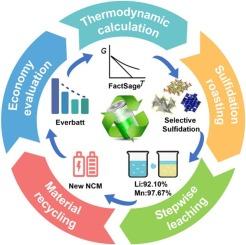Green collaborative recycling of spent NCM cathode and waste sodium sulfate via an unconventional process
IF 7.1
2区 环境科学与生态学
Q1 ENGINEERING, ENVIRONMENTAL
引用次数: 0
Abstract
Spent lithium-ion battery and waste sodium sulfate are hazardous solid wastes containing heavy metals and organic pollutants, both of which are difficult to dispose of safely. Here, we propose a collaborative disposal process to selective sulfidize spent lithium battery ternary material (NCM) with waste sodium sulfate by roasting, in which the Li in NCM is converted to water-soluble carbonate, manganese to acid-soluble oxides, and nickel and cobalt to insoluble sulfides. This favors the selective separation of valuable metals by stepwise leaching. Meanwhile, waste sodium sulfate provides essential sulfur and sodium sources, promoting selective sulfidation and grain growth to facilitate subsequent stepwise leaching. About 92.10 % of Li is extracted from the roasted sample after water leaching and 97.67 % of Mn is selectively extracted from the water leaching residue after the acid leaching. The nickel and cobalt are concentrated into the acid leaching residue, which can be used to directly produce commercial NCM materials. This study provides technical support for the short-flow recycling of spent lithium-ion batteries without conventional solvent extraction processes.

利用非常规工艺对废NCM阴极和废硫酸钠进行绿色协同回收。
废锂离子电池和废硫酸钠都是含有重金属和有机污染物的危险固体废物,难以安全处置。在此,我们提出了一种用废硫酸钠焙烧选择性硫化废锂电池三元材料(NCM)的协同处理工艺,其中NCM中的Li转化为水溶性碳酸盐,锰转化为酸溶性氧化物,镍和钴转化为不溶性硫化物。这有利于通过逐步浸出选择性分离有价金属。同时,废硫酸钠提供必需的硫源和钠源,促进选择性硫化和晶粒生长,有利于后续的逐步浸出。焙烧样品经水浸后可提取92.10%的锂,酸浸后可选择性提取97.67%的锰。将镍和钴浓缩到酸浸渣中,可直接用于生产商品化NCM材料。本研究为废锂离子电池的短流程回收提供了技术支持。
本文章由计算机程序翻译,如有差异,请以英文原文为准。
求助全文
约1分钟内获得全文
求助全文
来源期刊

Waste management
环境科学-工程:环境
CiteScore
15.60
自引率
6.20%
发文量
492
审稿时长
39 days
期刊介绍:
Waste Management is devoted to the presentation and discussion of information on solid wastes,it covers the entire lifecycle of solid. wastes.
Scope:
Addresses solid wastes in both industrialized and economically developing countries
Covers various types of solid wastes, including:
Municipal (e.g., residential, institutional, commercial, light industrial)
Agricultural
Special (e.g., C and D, healthcare, household hazardous wastes, sewage sludge)
 求助内容:
求助内容: 应助结果提醒方式:
应助结果提醒方式:


